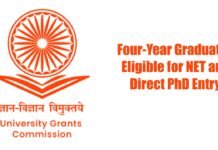
Key Points
- Biannual Admission System: Indian universities can now admit students twice a year July/August and January/February starting from the 2024-25 academic session, reducing wait times for students.
- Flexible Degree Completion: Students can choose to complete their degrees faster (accelerated program), on time, or slower (extended program), depending on their convenience and circumstances.
- Alignment with Global Standards: This policy aligns Indian higher education with international practices, enhancing global collaboration and student exchanges.
- Optional Implementation: Universities with adequate infrastructure and faculty can adopt this system, making it a flexible option rather than mandatory.
New Delhi: The University Grants Commission (UGC) has introduced a groundbreaking reform in India’s higher education system, allowing universities to conduct admissions twice a year. This policy, effective from the 2024-25 academic session, aims to provide greater flexibility and accessibility for millions of students while aligning Indian universities with global standards.
Biannual Admissions: A Game-Changer for Students
Under the new guidelines, universities will offer admissions in two cycles July/August and January/February. This shift eliminates the long waiting period for students who miss the initial admission cycle due to delays in board results, health issues, or personal reasons. The biannual system ensures that students can start their academic journey without losing valuable time.
Flexible Degree Completion Options
UGC’s policy introduces three pathways for degree completion:
- On-Time Completion: Students finish their degree within the standard timeframe.
- Accelerated Program: High-performing students can complete a three-year degree in 2.5 years or a four-year degree in 3–3.5 years.
- Extended Program: Students facing challenges can take additional semesters to complete their degree a three-year program in four years or a four-year program in five years.
This flexibility empowers students to tailor their academic journey according to their needs and circumstances.
What Are Accelerated and Extended Programs?
The accelerated program allows eligible students to fast-track their degrees by opting for this pathway after their first or second semester. However, only 10% of students who demonstrate exceptional performance will qualify for this option. On the other hand, the extended program supports students unable to complete their degrees on time by providing additional semesters.
Benefits of Biannual Admissions
- Enhanced Accessibility: Students who miss one admission cycle no longer need to wait an entire year.
- Boosted Enrollment Rates: More frequent admission opportunities are expected to increase India’s Gross Enrolment Ratio (GER).
- Global Competitiveness: Aligning with international standards strengthens India’s position as a “Global Study Destination” envisioned in the National Education Policy (NEP) 2020.
- Improved Employment Opportunities: Industries can conduct campus recruitment twice a year, benefiting graduates.
Optional Implementation for Universities
Adopting biannual admissions is not mandatory. Universities equipped with sufficient infrastructure, faculty, and support systems can implement this system at their discretion. This ensures that institutions transition smoothly without compromising academic quality.
Impact on Higher Education
This reform is set to transform India’s academic landscape by introducing greater flexibility and inclusivity. It not only benefits students but also enhances institutional competitiveness globally. With provisions like multiple entry-exit points and recognition of prior learning already part of UGC’s broader reforms, Indian higher education is evolving into a more adaptable and student-centric model.
















































